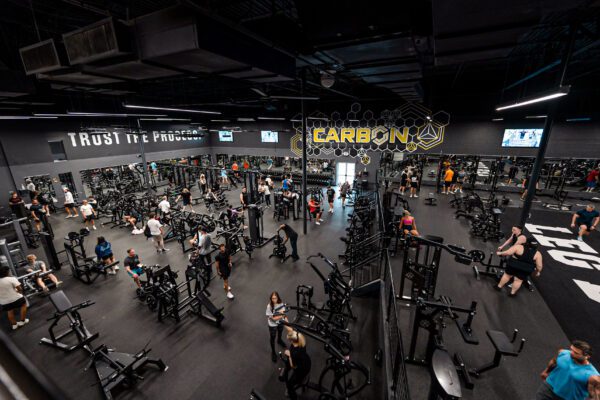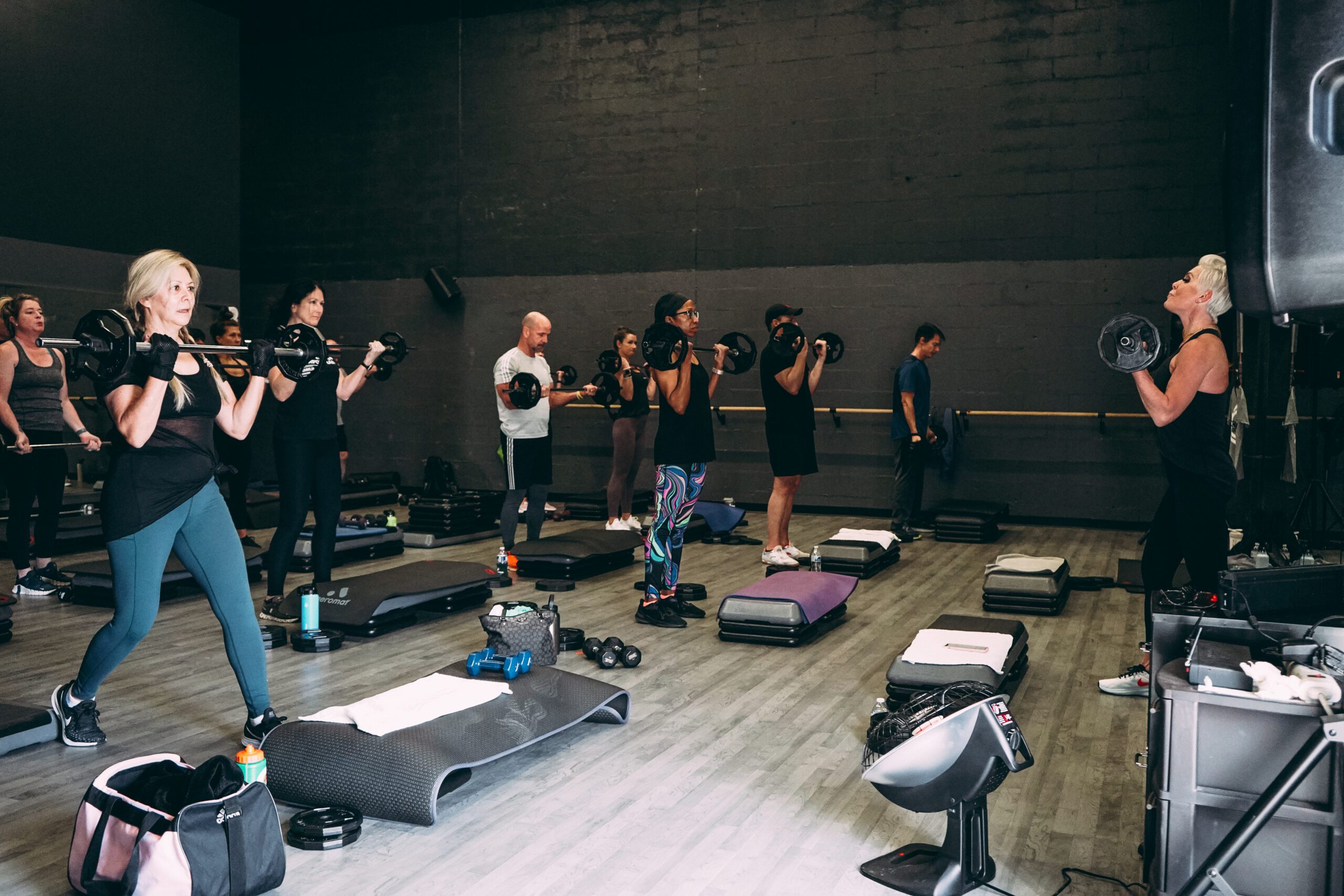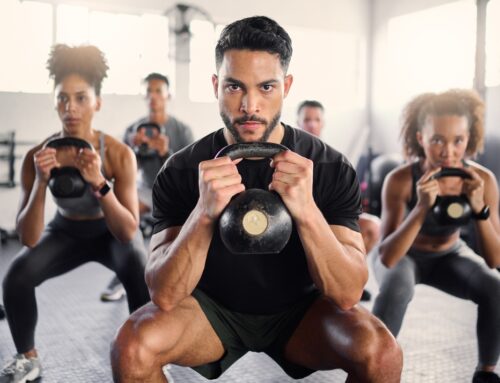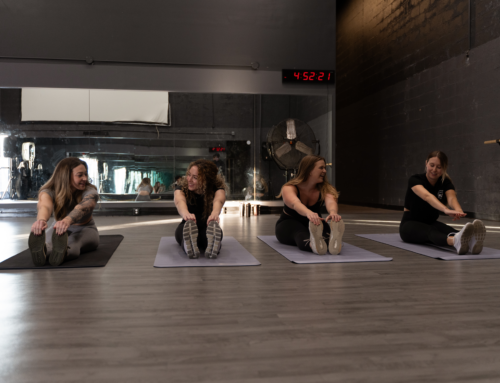If you’ve been in the world of fitness for a while, then you may have heard the terms “leg day” or “arm day” thrown around by some fitness enthusiasts. Those terms are exactly what they sound like: a full workout session focused solely on a certain muscle group such as the arms or legs. But, what about incorporating full-body workouts into your exercise routines?
Many avid gym goers have found positive results from full-body workouts. Instead of focusing entirely on one specific region of the body, this form of workout(s) targets the whole body and its muscles.
Full-body workouts are helpful for those whose fitness goals may be to create muscle balance in the body or enjoy feeling a muscle burn from head to toe! Let’s understand what a full-body workout looks like, how you can incorporate it into your workout routine, and the ways we offer it here at Carbon Performance.
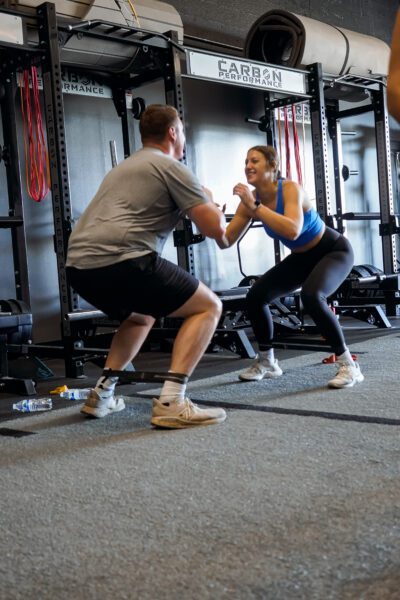
What is a Full Body Workout?
As previously mentioned, a full body workout is a form of working out that targets each muscle group in the body. Think of it this way, if you are working out for a full 60 minutes, you may target all three major muscle groups in increments of 20 minutes per muscle group. Meaning, 20 minutes are dedicated to your arms, the next 20 dedicated to legs, and the last 20 minutes focusing on the core. Or you can curate a 45-60 minute workout that implements movements that utilize all muscle groups at once, think deadlifts, lunges, and burpees, just to name a few.
Understanding Body Part Split Workouts
In contrast to a full body workout, a body part split involves dividing your workout routine based on specific muscle groups or movement patterns, scheduled on different days. This approach allows each muscle group to rest while focusing on another. For example, one might train chest and back one day, legs and core the next, then shoulders and arms on the following day. This separation can be beneficial for those looking to intensely focus on specific areas of the body during each session.
Comparing the Two Approaches
- Full Body Workout: Engages all major muscle groups in one session, ideal for those seeking a comprehensive workout in a limited time frame.
- Body Part Split: Focuses on individual muscle groups over multiple days, allowing for targeted training and recovery.
Choosing between these two methods depends on your personal fitness goals, schedule, and preference for variety or focus in your workouts.
Unlocking the Best Full-Body Workout
Finding the optimal full-body workout depends on your individual goals, whether it’s building muscle, increasing strength, or improving endurance.
Key Components of Effective Full-Body Workouts
1. Compound Exercises:
Focusing on exercises that target multiple muscle groups at once is essential. Consider including these fundamental moves:
- Squats: Great for engaging your quads, hamstrings, and glutes all at once.
- Deadlifts: An all-star for the lower and upper back, glutes, and hamstrings.
- Bench Presses: Target your chest, shoulders, and triceps effectively.
- Pull-Ups: A classic for strengthening the back, shoulders, and arms.
2. Exercise Variations:
Incorporate different variations to maintain muscle balance and prevent plateaus. For example:
- Try goblet squats or front squats in place of traditional squats.
- Alternate between sumo and conventional deadlifts.
3. Flexibility and Adaptation:
Your workout plan should allow for progression and adaptation. Change the intensity, volume, or rest periods as needed. For instance, gradually increasing weights or changing rep ranges can enhance strength.
4. Injury Prevention and Recovery:
Balanced routines don’t just build muscle; they also prioritize health and safety. Including proper warm-ups and cooldowns, alongside mobility exercises like yoga or dynamic stretches, can safeguard against injuries.
Remember, the best full-body workout is one that keeps you motivated and aligned with your fitness objectives. Listen to your body and make adjustments as you progress to maximize benefits and minimize risks.
Benefits of a Full Body Workout
We’ve previously gone over the benefits of exercise in other posts, and narrowed in on the benefits that come from different forms of exercising such as weighted ab exercises and cycling. A full body workout is no different in the benefits that someone can reap from consistent dedication to this kind of exercise. Some benefits from a full body workout include, but of course are not limited to:
1. 3-in-1 kind of Workout:
Since this form of exercise targets all major muscle groups, it’s a great option for those who may not be able to commit to a split workout routine. Their schedule may only allow them to visit their gym 2 -3 times a week, meaning their time to devote to a gym may be limited.
Because of this, a full body workout is an ideal workout for the person who wants a productive, impactful workout that makes the most of the little time they have to spend at the gym that makes
2. Promotes Rest Days:
Since you are targeting your entire body in this form of workout, you can enjoy more days to recover, or rest. Some individuals may not be able to participate in workouts each day due to schedule or or due to physical restrictions. Some individuals may benefit from more rest days if they find that they are more sore than normal after a workout or dealing with a current injury. It is always important to listen to your body before, during, and after a workout as this can help you navigate if you can do more or need a day or two of rest.
Optimize Your Recovery for Better Results
To truly optimize your workout recovery, it’s essential to give your muscle groups at least 48 hours to recover between sessions. This allows your muscles to repair and grow stronger, leading to better results in the long run. If you’re eager to maintain a consistent workout routine, consider incorporating a body part split workout program. This approach lets you target different muscle groups on consecutive days, ensuring each area has ample time to recover.
Remember, it’s not about working out harder but smarter. While it might feel like you’re not doing enough by taking rest days, integrating them into your routine can actually accelerate your progress. Recovery is a crucial component of any fitness regimen, so don’t underestimate its value. With proper rest, you’ll not only avoid overtraining but also enhance your overall performance.
Individuals who incorporate full body workouts can better prioritize and include rest in their health routine. Since each major muscle group is being targeted, they don’t have to worry about missing out on certain muscles.
3. Improved Mental Health:
The team at Carbon Performance have previously talked about the ways a consistent workout routine can impact mental health, and a full body workout also can impact your mental chemistry in a positive way. Multiple studies show that workouts release endorphins, also known as the “feel-good” chemical in your brain to reduce stress and anxiety. Imagine how you will mentally feel after one workout a week: pretty good! Now, multiply that one workout session by five, and then imagine how even better you will start feeling mentally. Consistent exercise is a great tool in combating anxiety, stress, and many other mental conditions.
4. Better Sleep:
The reason any workout can provide better sleep is simply due to the fact that a strong workout will tire out your muscles and your body. Meaning, your body will need time to recover, and sleep is one of the main ways our bodies can recover from an intense workout.
Since full body workouts are targeting your entire body within one workout session, you can trust you will be sleeping well that night! Because sleep is not just an important part of our lives, it is crucial to ensure you are getting quality sleep to feel rested and ready to go for whatever the next day brings.
Full body workouts are like magic in how they provide a way for us to strengthen our entire body, while also tiring out our muscles which gives us the ability to fall asleep and stay asleep into the night.
5. Fat Loss:
Lots of individuals have specific goals for working out, and weight loss is one of them. While there is definitely more that goes into losing fat than just a consistent workout routine (such as an adequate diet), a full body workout is a guaranteed way to lose the excess fat.
Since this form of working out targets all major muscle groups, you will be getting the most out of your workout routine. This is ideal for the individuals who may not be able to commit to multiple days in a gym due to scheduling, but still are looking for fat loss results.
In fact, a full body workout, with high intensity, can trigger EPOC (excess post-exercise oxygen consumption) which helps to restore your body after an intense workout. Since you’re activating multiple muscle groups at one time, you are also increasing your calories being burned!
How to Fit Full Body Into Your Routine
Now that you have an idea of what a full body workout is, and the benefits of it, let’s look into the ways you can incorporate it into your already set workout routine. If you’re already an avid fitness enthusiast and gym goer, a new addition to your fitness routine could look like the following:
Sample Full Body Workout Schedule 1
Monday: Leg Day (45 – 60 mins)
Tuesday: Rest
Wednesday: Full Body Workout (45 – 60 mins)
Thursday: Rest
Friday: Arm Day (45 – 60 mins)
Saturday: Rest
Sunday: Full Body Workout (45 – 60 mins)
If you are someone who can only to commit to fewer days in the gym, here is another way to incorporate full body workouts into your routine:
Sample Full Body Workout Schedule 2
Monday: Rest
Tuesday: Full Body Workout (45 – 60 mins)
Wednesday: Recreational sport, roller blading, or a power walk in your neighborhood
Thursday: Full Body Workout (45 – 60 mins)
Friday: Rest
Saturday: Active Rest
Again, this is just a rough idea of how you can incorporate a full body workout into an already set fitness routine. Everyone will look different based on their goals and personal schedule. The main idea with incorporating a full body workout into your routine is understanding the balance it can bring to your entire body, and how it can create margin for more rest periods for your muscles.
You can also get creative with full body workouts, especially if you do not want to devote a full 45 minutes or 60 minutes to this form of fitness. One way could look like using 15 or 30 minutes out of your workout time to focus on full body exercises. The beauty of a full body workout is that you can adjust it to fit your goals and current routine.
Best Full Body Exercises
With a framework of how you can incorporate a full body workout into your fitness schedule, you may be curious as to what these exercises actually look like. Some suggested exercises to incorporate may surprise you, as you may already be doing them and not realizing how they are activating all your major muscle groups! Let’s look at what some of these look like:
- Squat with dumbbell: select a moderate to heavy weight, and hold close to chest, squat.
- Deadlift with dumbbell: select a moderate to heavy dumbbell per hand, perform deadlift while holding dumbbells.
- Bent-over row with dumbbell: select a moderate to heavy dumbbell, hinge forward at hips, with a flat back, and slight bend in the knees, keep elbows tucked and extend arms backward
These are just a few full body workout exercises to add to your routine. There are plenty of other ones that our fitness trainers at Carbon Performance incorporate into many of our classes. With this kind of exercise you will be sure to feel the burn, while also seeing results and reaching your personal fitness goals.
Full Body Exercises for Beginners
Maybe you are newer to the fitness world and just now getting in a consistent workout routine. The idea of adding a new form of exercise can be daunting, but even if you are a beginner to fitness there are simple ways to include a full body workout into your schedule. If you are already committed to spending 2-3 days in the gym, consider focusing one of those days on a full body workout, or giving 15-30 minutes of time to a full body exercise within your set days.
Here are some full body exercises with no equipment for beginners:
- Burpee: engage legs, activate core, and jump into squat. Transition into kicking legs behind, with a flat back, to go into plank position, into a push up. Here you will be activating all major muscle groups.
- Planks: activate core, while using upper shoulders and legs to stabilize yourself.
- Push Ups: activate core, while engaging legs to stable yourself, and shoulders/arms to push yourself away from the floor
These forms of exercises, such a rowing machine or strider machine, you may be familiar with, but you have to ask yourself the question, am I actively engaging all my muscle groups while performing these reps? That is how you will see more results when incorporating these kinds of full body exercises.
A Few Full Body Workout FAQs
- How Long Should a Full Body Workout Be? A good, and impactful, length of time to aim for when doing a full body workout is anywhere between 45 minutes – 60 minutes. As you grow more muscle and endurance, with the appropriate diet, you may be able to extend your time by another 30 or 60 minutes.
- When Will I Start to See Results from A Full Body Workout? With discipline, consistency, and a good diet, you can expect to see results from a full body workout in as early as 6 weeks. From here you should continue to see results as you get closer to the 8 and 12 week mark. But, these results will be more evident when you make the exercises incrementally more challenging as you grow stronger, in addition to a strong diet.
- What Does It Mean to Be Consistent at the Gym and With Full Body Workouts? We all have busy schedules, but we also have the ability to prioritize the things that are important to us. And health should always be a top priority. Consistency at the gym can look like committing to 2-5 days per week, with 45-60 minute workouts per session. Those sessions can be focused solely on full body exercises, or a blend of different exercises. Eventually this rhythm will become like healthy habits in your own life and second nature!
- But, How Can I Be Consistent at the Gym? Valid question! This can look like a few things for you. Maybe you do better in group fitness, where you are surrounded by other individuals who are reaching for the same goals, and a skilled coach to keep you motivated and accountable. You can also create a timeline of your growth, think before and after pictures! Or have a friend join in on the journey with you, be it a partner, friend, or coworker. This can help you to feel more comfortable when working out, and keeps you two accountable to reach your goals.
- What’s The Difference Between Compound Exercises and A Full Body Workout?
Compound exercises can be incorporated into full body workouts because they hit multiple major muscle groups within one rep. - Is a Daily Full-Body Workout a Good Idea? Performing a full-body workout every single day might seem like a rapid path to fitness, but it’s essential to understand the importance of recovery. While motivation is key, overworking the same muscle groups without allowing adequate rest can lead to fatigue, decreased performance, and even injury.
- Why is Recovery Important? Muscles need time to repair and grow stronger after being worked. Typically, experts recommend allowing at least 48 hours of rest for the muscles targeted in a workout. This recovery period is crucial because it enables your muscles to rebuild and adapt, which is a fundamental part of gaining strength and endurance.
- How do you Maximize Your Workout Plan? If you’re eager to stay active every day, consider adjusting your routine. A split training program can be a beneficial alternative. This approach involves focusing on different muscle groups on different days. For instance, you might train your upper body one day and your lower body the next. This variation not only prevents burnout but also allows each muscle group to recover adequately.
Listen to Your Body
Ultimately, everyone’s physique and endurance levels vary. Paying attention to how your body responds to exercise is crucial. Signs of overtraining include prolonged soreness, fatigue, and a plateau in progress. Adjust your routine as needed to maintain a healthy balance between activity and rest.
Full Body Workouts at Carbon Performance
If you’re looking for a gym where you can find an engaging community, credible personal trainers eager to help you reach your fitness goals, and state of the art workout equipment, then Carbon Performance is the gym for you.
We offer an array of classes which include full body workouts to restorative workouts and everything in between. Some of those classes include:
- Les Mills Body Pump
- Cycling
- Mat Pilates
Just to name a few!
With two locations in the greater Nashville area, you are sure to find your fitness home with us at Carbon Performance. If you’re curious to learn more about how we can help you reach your fitness then consider scheduling a free consultation with one of our personal trainers. From here we can answer any questions you may have, and share more about our membership. We offer three different forms of memberships with unique benefits to meet and serve you best.
No matter where you are on your fitness journey, Carbon Performance is here to join in! Find a Carbon Performance location near you today.
